Chris Baty's Blog, page 117
October 4, 2017
NaNo Prep: Four Questions to Ask Yourself When Writing Diverse Characters

We’ve officially entered NaNo Prep season, and this week
we’ve asked some participants for their thoughts about building strong characters.
Today, Municipal Liaison Aurora Hurd shares some tips on how to responsibly create diverse characters:
So, you want to write a novel and you want it to represent the world around you. This inevitably means writing about characters who may not be like you in their identity and/or background. Below is a list of questions to keep in mind while creating characters different from yourself:
1. Are you using stereotypes without meaning to?Sometimes it is obvious if you are slipping into a stereotype, sometimes it is not. The best way to avoid stereotypes is to write well rounded characters. If you know your character’s greatest goal, their greatest weakness, what makes them happy and sad, it is harder, if not impossible, to write stereotypes. But if you are still not sure if you are falling into a problematic trope, research is your friend. There is a lot of writing on what to watch out for when it comes to stereotypes big and small (for example, on the long history of writing villains as gay or gender-nonconforming—equating such traits to being evil). Use your favorite search engine to check and use the tips from the other posts this week to build complex characters.
2. Ask yourself, would you want someone of the background/identity you are writing about to read your book?If the answer is no, then you have a huge red flag that a lot of work needs to be done. First, make a list of why that is. Then, it is time to hit the books (or the internet) and it is time to talk to people. Ask people in the community you are writing about what they would like to see in characters. Ask them what they do not want to see. Then go back to your writing.
3. Have you read books by authors of this identity?If not, now is a wonderful time! Not only does this support other authors, and authors that are often overlooked by bigger publishing companies, but it is also research, as all reading is. Reading diversely helps in writing diversely. Here are some good places to start: http://readdiversebooks.com/ and http://weneeddiversebooks.org/.
4. Finally, ask yourself why are you writing this character this way?This may be the hardest one to answer, because it may take some digging into yourself. If your answer is that this is just who the character is, you have answered all the above questions, and you have done your research, you are on track. But be careful of falling into roles like that of the white savior. Having good representation is powerful, but having people of a majority identity write about minority characters dealing with racism, homophobia, or ableism is not. This is because not only will it not come off as authentic, there is a high probability of getting things wrong. This is not to say only ‘write what you know,’ but to ‘stay in your lane’ and ‘do your homework.’
I want to finish this by thanking you for writing diverse characters! It is more important than ever for books to represent the world and the people within it. Representation matters, it builds understanding and acceptance which help dismantle systems of oppression when done right. Keep these questions in mind and get ready to write this November!

Aurora Hurd is a bisexual writer of all things in the realms of the fantastic. She is an ML for USA :: Vermont, and is currently seeking her MFA in Creative Writing. For more writing, visit Aurora on Twitter and Tumblr.
Top image licensed under Creative Commons by Edward Peters on Flickr.
October 3, 2017
NaNo Prep: How to Write Believable Characters (and Push Your Word Count!)

This week, as we gear up for NaNo Prep season, we’ve asked some participants for their thoughts about building strong characters. Today, author and participant Jenn Flynn-Shon shares her advice for creating characters that jump off the page:
A story driven by character cuts deeper, elicits raw emotion, pulls from the setting, theme, plot, and five (six?) senses of your characters to create a fuller, richer story.
Character, according to the dictionary, is:
1. the aggregate of features and traits that form the individual nature of some person or thing.
2. one such feature or trait; characteristic.
3. moral or ethical quality.
As fiction writers, we develop those features, traits, morals, and ethics into a living, breathing person (animal, robot, etc.) on the page. Which begs the big question––how do some authors craft such believable characters that jump off the page, and how can I do that, too?
1. Think of them as real people.Take a look at yourself in the mirror. Do you see skin, hair, eye color? The set of your jaw? The neckline of your shirt? Physical description is an important element to developing any character––but physical descriptions are often brief, and during NaNo, words are key.
So, let’s look at how to punch up word count and develop your character.
Consider two different women. Let’s call them both Liz. Both have blue eyes and sport a black shirt. Basic physical characteristics.
Snore, right?
Punch up the character and give them life by using actions and evocative words to describe their physical traits: consider where they come from, where they live in your story, who are the people that surround them, what is their goal in your story, and other traits that make your character an individual.
Then, instead of dropping physical descriptions into your story so matter-of-fact like above, you’ll write something like this:
Liz One flips her mahogany ponytail behind her back and studies her reflection. With a frown, she contemplates ditching the faded, ratty black concert t-shirt she’s wearing. Stolen off the merch table that night she snuck out of her parent’s house to go to the show back in 1988. The last night she was single. A slick layer of salty tears well up under her blue eyes, threatening the surface.
And the other?
Liz Two takes her fifth deep breath in a row to ward off the impending anxiety attack. In the mirror, she watches her mousy brown bob move up and down against her neck. Quick at first, then slower with each exhale. Her lids drop and she’s no longer searching her own blue pools for courage. As she hitches her bra strap beneath her smart black top, she realizes this is the first time she’s going on an interview for a job she really wants.
Even though their physical descriptions are identical, those two women are definitely different. And, as a bonus, you’ve just beefed up your word count.
2. Your character isn’t you.To really bring life to a character, we need to consider their entire story. Who they are in their heart, soul, core. October is the time to start writing all of that backstory down!
Do they like to swim, ride a bike, dance around their kitchen eating raw cookie dough off a wooden spoon? Are they multi-lingual? Still living at home in their fifties?
As every author writing them is different, so are the characters that bring our stories to life. Collect the backstory details about all those little quirks now, and your job of injecting descriptive details in November will be that much easier.
Because, the better you know your character’s motivations, goals, background, morals, and physical traits, the more real they become to you. And then, hopefully one day, to your reader, too!

Jenn Flynn-Shon is an author, snarky blogger, and micro-press owner. Her first novel, Ripple the Twine (retired), began as a
steaming pile of word goo during NaNo, 2009. After many edits, Jenn
self-published that book in 2012. She’s released eight titles
since, including the fiction writer’s guide, 30 Chapters in 30 Days: Write a 50,000 word first draft without feeling blocked. Jenn loves to connect with writers and readers on Facebook and Goodreads.
Top image licensed under Creative Commons from photosteve101 on Flickr.
October 2, 2017
Join the League of Extraordinary Wrimos
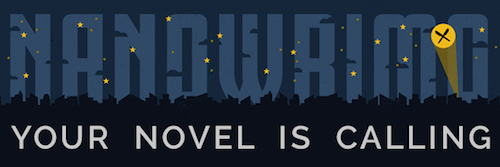 Announce your 2017 NaNoWriMo novel today!
Announce your 2017 NaNoWriMo novel today!The time has come, writers: your novel is waiting to come into the world. Will you answer its call?
You can now announce your 2017 novel on the NaNoWriMo website. Add a title, genre, cover image, synopsis, and even a short excerpt if you’ve already made a head start on writing. (Need a quick refresher on how NaNoWriMo works? Here’s how.)
You can challenge yourself or your writing buddies to a word sprint, chat with other Wrimos on our forums, and check out our NaNo Prep page for events and inspiration leading up to November. We’ve also got our full line-up of 2017 Pep Talkers and NaNo Coaches up!
Don’t forget to check out our brand-new store to pick up some superpowered NaNo merch or a limited-edition writing prompt poster. Oh, and be sure to pick up some cool NaNo flair for your social media sites to let your friends know about the challenge you’ll be undertaking this November.
Welcome to the team, writers!
September 29, 2017
NaNo Prep: How to Make a Timeline
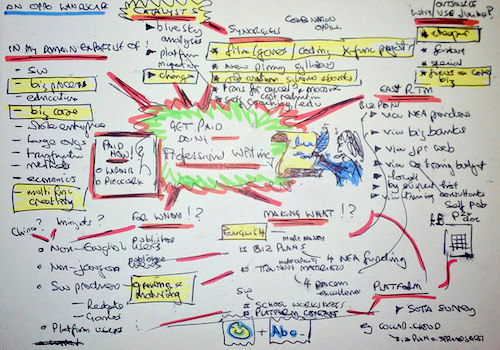
As we dive into NaNo Prep season, we’ve talked to some participants to get the inside scoop on how to best prepare for November. Today, participant Juliana Xavier shares how to plan out your story, even if you’re a committed pantser:
When you think about NaNoWriMo, do you find that your palms are sweaty, knees weak, arms… heavy? If so, congratulations, Rabbit, you’re in the process of panicking about the grueling (yet fun!) month of noveling that is fast approaching (sans spaghetti, I hope).
Not to worry, I––a six-year veteran of NaNoWriMo––am here to teach you everything you need to know. I even succeeded in reaching the 50k goal during my very first year.
Here’s what my prep the week before November 1st looked like that time:
Denial (that I could ever write a novel)Anger (that I’d set myself up to fail)
Bargaining (in hopes that 50k words would magically show up in my word document)
Depression (just, uncontrollable sobbing)
Acceptance (might as well get it over with, since I set up a profile and everything)
The following years were all about false hope. I had done it once before. All I had to do was repeat the previous year’s recipe. No real prep necessary as long as I had a story in mind. Easy peasy right?
Narrator: It wasn’t.
All kidding aside, it took me years to find a prep style that worked. By the third year, I started moving from pantser to plotter. The first years were spent simply trying to prove to myself that I could write 50k. It didn’t matter what I wrote as long as I hit that number. I’d proven to myself that I could, now I needed to find a way to do it coherently: a story with beginning, middle and end.
That’s where timelining comes in. If you’ve never done a timeline before, it’s what bullet journaling is to a diary entry: a way to list the most important facts of your story, in a way as to not lose yourself (that Eminem song’s gonna be stuck in my head for at least a week now).
No dialogue, no senseless descriptions, no drama, no fluff. Just a grocery style list of things that need to happen in your story.
Start with your main plot points:Hero leaves home.Hero meets new friends.
New friends betray the hero.
Epic battle!
Hero returns home changed.
Then, break those down even further, trying to figure out the different drives that move the story forward.
Part 1:Hero doesn’t want to leave.Hero’s home is mysteriously burned down.
Hero has nothing left.
Hero leaves home.
Not enough? Break it down some more! Break down individual chapters if you have to. Just remember to start simple so you don’t get lost within plot.
How many times you break it down is up to you, but I find that three times does the trick. More than that and you’re just using the timeline as an excuse not to get actual work done… (guilty!)
And that’s it!
So, whether you’re the type of person who offers up your kid brother to the gods in exchange for uninterrupted hours of enlightened writing; or you dance half naked in (preferably) your own backyard during the full moon, chanting the wrong song lyrics to whatever tune is stuck in your head that week… I think it’s safe to say that there’s no real bad way to prep for something as important as writing your very own novel.
But if you’re still stuck? Try a timeline! We’ll be cheering you on just the same.
Signed,
Your friendly neighborhood Wrimo participant.

Juliana Xavier is a writer, illustrator and has a BFA in Sequential Arts from SCAD University. Brazilian born but partially American grown. Works as a freelance artist and would love to draw your fantasy maps and covers for books. Hates coffee (gasp!) but thinks that Thai bubble tea makes everything right with the world. You can find her on her portfolio website, Twitter, Patreon, and Facebook page. For inquiries, feel free to e-mail her at juliana.m.xavier@gmail.com
Top image licensed under Creative Commons from Julian Partridge on Flickr.
September 27, 2017
NaNo Prep: Advice from a 10-Time Plantser
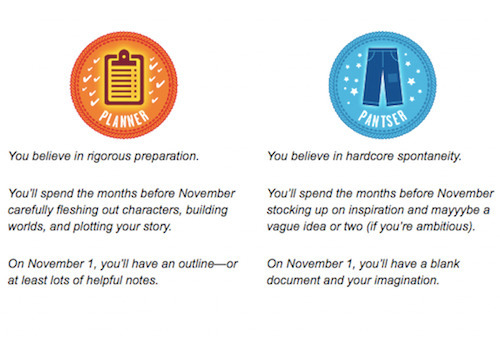
As we dive into NaNo Prep season, we’ve talked to some participants to get the inside scoop on how to best prepare for November. Today, participant Lexi Vranick shares how to plan, but not too much:
So, you’re a plantser.
In laymen’s terms that means you’re the novelist toeing the line between scout-level preparedness and spontaneity central. You’re the one digging up fossilized plot points so that you can polish them in November. You want to have a plan, but you don’t need it to be whole. You just need it to exist in all its fragmented glory so that you can spend November fitting all the pieces together.
Plantsing is great. I swear by it. I’ve spent a decade of NaNoWriMos with it. But it can be risky. It can open up doors to writer’s block, inspiration draughts, and sudden panic. That’s why strategy can be so important, and it’s why I’m here to share some of my favorite plantser tips for getting ready for November.
1. Get some road trip tunes.I can’t write without a playlist. Actually, I can’t do anything without a playlist, but that’s beside the point. Music is inspiring. It can help set the tone of the story, shape your characters’ personalities, and even mold their relationships with each other. Gather up songs that fit the tone you’re aiming for. Start with what you know, then branch out by listening to online playlists and talking to people in the NaNo Soundtracks forum. And a tip on that tip? Continue to add to your playlist even into November. The longer the list is, fewer individual songs will repeat, and the less likely you’ll be to get bored with it.
2. Guard against writer’s block.Writing without a blueprint is freeing, but it can also leave you open to Sudden Onset Writer’s Block. The good news is that you don’t need an outline! But you should have emergency scenes. Buy a pack of index cards and jot down scene ideas. Something as simple as, “John and Anna argue about their relationship” will suffice. Come November, when you find yourself in a rut, you’ll be able to reach for a card and start a new scene!
3. Face your novel.Get on Pinterest. Get on Google. Look up actors, or aesthetics, or poetry and gather it all up into an inspiration board for your novel. Pick a “dream cast” to help you envision your characters. Gather photographs that fit your novel’s tone. You’ll have something to look at when you hit a block in November, and you never know when you might stumble upon something that might inspire a new scene or character.

Lexi Vranick is an independent poet and fiction author based in Long Island, New York. She is the self-published author of Ready Aim Fire: A Poetry Collection and Basket Case: A Short (Short) Story Collection. She is a member of the Long Island Writer’s Guild and a student at Gotham Writer’s Workshop. She is a nine-time participant and eight-time winner of National Novel Writing Month. She can sometimes be seen at her local book shops, searching for stories at the bottom of coffee cups.
September 25, 2017
Road Trip to NaNo: Finding Magic in the Mundane

NaNoWriMo is an international event, and we’re taking a Road Trip to NaNo to hear about the stories being written every year in our hundreds of participating regions. Today, Laura Cerrone, our Municipal Liaison in the USA :: New York :: Nassau County region, talks about using your surroundings to create multifaceted characters:
A twenty minute drive, and I can plant my feet in the spot where Fitzgerald stood nearly a century ago, imagining Daisy Buchanan’s pulsing green light over the Long Island Sound.
With the skyscraper shadows cascading over the Western region, and the Eastern areas opening up to our more rural sister region, Nassau County is easy to miss on a map. Tucked in between our county lines is the simplistic suburban living that is often taken for granted. It’s not seen as trendy or mysterious as a city, or as bucolic and charming as the countryside. Suburbs are just ordinary.
In my corner of the world, ordinary can be peeled back to reveal a kind of surreal magic, such as the gilded Gold Coast mansions on the North Shore and the sandy beaches to the south. Even our strip malls and neat rows of houses with manicured lawns possess a very different, but still remarkable kind of magic. While Fitzgerald likened the glamorous West Egg and flashier East Egg in The Great Gatsby to the affluent areas of Great Neck and Manhasset Neck, President Theodore Roosevelt once stated, “There could be no healthier place to bring children up.“ The Nassau County region with its layers of magic cannot be pinned down to one stereotype––and you might be surprised at what you find in your own region when you peel back the curtain to the seemingly mundane around you.
My home base straddles these dichotomies. I am enamored by the daily routines my neighbors partake in each day: running to the dry cleaning, or picking up their children from lacrosse, or going for an early night stroll on the Long Beach boardwalk. But I also have neighbors who remind me of Jay Gatsby, winding down the Long Island Expressway in their beautiful and expensive cars. Many of the characters in my stories have manifested qualities akin to both of these kinds of people. Some of these characters can even espouse the entire history of the rise and fall of an industrial area, just like the curators at the Cradle of Aviation tell the stories of Long Island’s rich aviation history.
“For this upcoming NaNoWriMo, I challenge you to think of each of your characters as multi-faceted. This includes thinking of your settings as a character in itself, because a town or a city can have a plethora of its own personalities and moods.”Sitting on a bench at my local strip mall can provide me with enough inspiration just probing for the deeper stories behind passers-by. There’s the young woman in leisurewear, popping in and out stores to get her chores done in a timely fashion; there’s the new dad, loosing a public battle with his toddler throwing a temper tantrum; and there’s also a child, little fingers wrapped around her occupied mother’s hand, observing trash on the street that would otherwise be boring, reminding me of the openness and innocence of curiosity. I look at all these people and think about their stories. Are they from here? How did they get here? Are they struggling to pay their bills? What secrets are they hiding? Digging a little deeper cuts out the stereotypes we are predisposed to think and makes for a richer character and body of understanding.
For this upcoming NaNoWriMo, I challenge you to think of each of your characters as multi-faceted. This includes thinking of your settings as a character in itself, because a town or a city can have a plethora of its own personalities and moods. Whether you pants it or plan it, pull inspiration from your neighbors, the places you really love to visit in your backyard, or the ones you can’t even stand. Writing about your own roots can be a test in itself because too often we overlook the beauty in the minute detail. Step aside from the computer screen or your pen and paper and observe, critically think, and be curious about the people around you and their stories.

Laura is a first year Co-ML for the Nassau County region of New York. She’s lived here her entire life (except when she went away to college, although she remained loyal to her native region of New York). She’s a biography writer by day, an entertainment/pop-culture freelancer by night, and somehow fits in the time for all her NaNoWriMo endeavors.
Top photo by Laura Cerrone.
September 22, 2017
NaNo Prep: Novel by Bullets
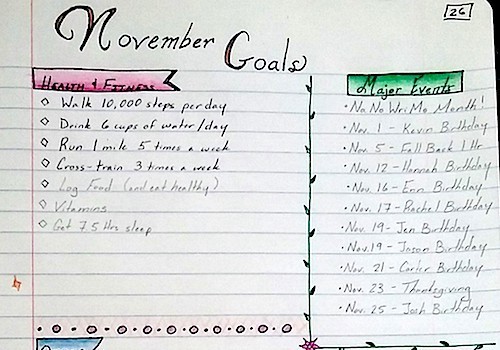
As we dive into NaNo Prep season, we’ve talked to some participants to get the inside scoop on how to best prepare for November. Today, participant Jessica M. Leong shares the beauty of a bullet journal:
For many people, the keys to starting off strong in November are having a solid outline prepared ahead of time, and having a solid understanding of how your novel’s world works. This helps you stay on track with your novel’s game plan as those long November days (and nights) wear on. However, if you’re like me—the kind of writer who struggles with organizing your outline (and your thoughts more generally)—then a bullet journal may be the way to go.
Bullet journals tend to look intimidating because of the amount of creativity that can go into them. But don’t be discouraged! While they might look beautiful and complicated, you need to remember that bullet journals are customizable. It’s really about functionality: what’s going to help you be the most prepared for November. For me, having a multiple notebooks took up a lot of space and it was time consuming to organize. But when I was introduced to bullet journaling last year, I knew it was a perfect fit.
What is a Bullet Journal, Really?When learning about bullet journaling, I realized that it didn’t matter whether a bullet journal was all decked out in colors and artwork or done simply with black pen; all of them have a common purpose. It is a place to merge all that you write, plan, and think about so you don’t need to have multiple notebooks around. So really, a bullet journal isn’t any one particular item; rather, it’s a flexible method of organizing all the things you need for your novel. No matter what it is (world building, goal setting, outlining, random musings, etc.), all of it can go in your one bullet journal.
Putting Together a Bullet JournalPutting together a bullet journal doesn’t have to be complicated or take a lot of time. However, all bullet journals should have these four important features:
An Index: Leave 2-3 pages at the front of the journal for the index. This is where you’ll note where everything is in the journal, along with the page(s) it’s on. This will help you locate specific things quickly when you’re writing your novel.Numbered Pages: To stay organized, you need to number your pages so you know where everything is according to the index that you made. I like to number the pages as I go so that if I make any major mistakes, I can tear the page out without messing up the page count.
Bullets: This is where the journal gets its name! Bullet points are used as the core structure in bullet journaling. These bullets are comprised of short sentences used to organize notes under categories that you make. You can add as many or as few bullets as you’d like to each category that you create.
Thick Pages in the Journal: Decently thick pages are a must, unless you like ink bleeding through or an ink shadow which can obscure your writing on the other side.
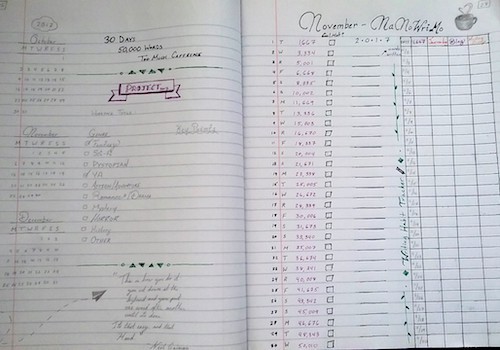
The best part is, you can do whatever you want with the bullets to organize your thoughts. If colored pens, highlighters, and coloring pencils are your thing (like me), then go ahead and use them! If not, that’s entirely acceptable too. Plus, this useful technique isn’t limited to plotting; it can be used to plan your daily life as well! Again, different things work for different writers, so don’t be afraid of experimenting with different bullet-journal types and other organizational techniques to see what will best help you get through NaNo without losing track of your novel.

Jessica M. Leong is a developmental editor, social media specialist, and fantasy, science fiction, and dystopian writer who enjoys colliding the genres together whenever the inspiration strikes. In her free time she enjoys movie night with her loved ones, training guinea pigs—including her own, named Willow—and looking for her next adventure. Having joined back in 2006, this year will be her twelfth year participating in NaNoWriMo.
September 20, 2017
NaNo Prep: Make a Box for Your Bully

As we dive into NaNo Prep season, we’ve talked to some participants to get the inside scoop on how to best prepare for November. Today, author Mur Lafferty shares how she manages to make her inner editor be quiet:
I’m writing a new book now. I hate it.
This is standard, whether you’re a pro or a beginner. The idea in my head was so glorious and perfect, but the minute I put it into words I feel like a finger-painting four year old, except kids take more pleasure in their creation than I do. Nah, this is drek.
And I hear them, the little whispers in my ear: “This is crap. Just quit. No, not just this book, you should quit it all, stop calling yourself an author. Go back to corporate America and make room for someone else who’s more talented." I turn my head and sitting on my shoulder is a little person shaped like a potato. It’s lumpy and ugly and has a permanent smirk on its face like it knows it’s better than me.
This is my bully, my constant companion, my internal editor––and I would bet my next advance (that isn’t coming, remember, because this book is crap and definitely won’t sell) that you have one similar to it.
My bully’s name is Travis, by the way. But I’m not here to talk to you about Travis the bully potato. I’m here to talk about your potato, or whatever your editor looks like, and to talk about how to prep for the novel you are going to write in November.
1. Identify your bully.As I said, mine is a potato. No, I don’t know why it’s a potato, shut up. You might follow standard pop culture mythology and make yours into a devil, or an angel with black wings, or a little version of you, with a goatee, dressed like a delinquent. Incidentally, your muse is usually the one on your other shoulder. Mine isn’t another vegetable, although it would be balanced and tidy if it were a pretty vegetable maybe like a fennel bulb with long flowing hair. But it’s more like a friendly fairy that is easily harassed into silence by Travis the Potato. Freaking Travis, man. I hate that guy. But anyway, once you identify your bully, and realize that what it’s telling you is all lies, you can accept that you’re not realistic when your subconscious says to quit; you’re just having fear. Doubts. And that’s normal.
2. Grab it!Once you can identify and spot the wily bully, grab it with all your might. It’s like a nettle, which I have never seen, but I hear you have to be firm when you grab or else you’ll get stung. Instead of grabbing nettles, grab that bully by its potato and don’t let go. It will whine. It will fuss and squirm. It will tell you that without it, you will write something terrible and not even know it. That’s OK, just don’t let it go.
3. Get a box.We’ve been talking metaphorically up to now. No, I don’t really think a potato named Travis sits on my shoulder. But I’ll admit I sometimes do something physical to shut it up. I’ll close the office door. I’ll turn up music so I can’t hear it. Or I’ll get the time-out box, which is a little chest on my desk. The bully goes into the box while I write, and I promise I will let it out when I’m done. It can complain and insult me all it wants, I can’t hear it from the box. So either imagine your box, or heck, get yourself a real box. NaNoWriMo is not for the faint of heart, and the sturdy-hearted writers have boxes, dang it.
(Aside––why am I talking so much about potatoes? Because the bully is what will keep you from your novel. If you’ve failed NaNoWriMo in the past, then you know that unless something catastrophic happened, you quit because you had doubts, or fears, or just wasn’t sure what to write next and you let the blank page––the bully’s cousin––get the better of you. Before you write word one on your book, you must decide where to put that bully, or it will do all it can to stop you.)
4. Spread the word.What you’re doing is a big deal, a large venture, and if you’re in the USA, then it’s happening during a major holiday as well. You will have a greater chance to succeed if you tell the people close to you what you’re up to, and what it means to you. That last part is key. You’re not just trying out a new hobby, you’re challenging yourself to accomplish something at a pace that some pro writers find difficult to maintain, much less beginning writers. If your family, friends, roommates, etc, don’t respect that, it’s going to be much harder on you. Establish a time you want to write daily and then request help from those close to you to give you the space you need. And if they don’t help you, call them all potatoes and slam the door.
5. Make an outline. Or don’t.Outlining can be quite useful. It gives you a roadmap that you can follow as you work on your book. If you don’t know what to write that day, then the outline should point you in the right direction. However. You might be like me, and the thought of writing an outline makes you want to take all the advice that the muffled potato in the box is still shouting at you: quit quit quit. It’s possible that maybe outlining isn’t for you. And that’s ok. Some prefer maps. Some can’t fathom the shape of the story until they’re out with a flashlight, making their way through it, only knowing what to write when their light falls on it. That’s how I prefer to write. So yeah, make an outline. Unless that isn’t something that works for you.
6. Don’t fall into the rabbit hole of advice. Even this one.I’m a pro writer (that still feels weird to say) and I still get paralyzed when looking up advice and tips and tricks instead of actually writing. Many beginning writers have been halted in their tracks when they come across writing advice that goes counter with how they do things. "If you don’t do [X] then you’re not a real writer,” is my favorite. It makes me want to find my knives.
I’m betting you know more than you think you do about how to do this. The rules are simple: get to 50k by the end of the month. For most, that means writing daily. That may not work for you. For others, 10000+ words on the weekend may work. Worried that your Rashomon-style retelling of King Lear, only in present tense, second person, and set in the far future isn’t going to work? Write that thing! Don’t get bogged down wondering if your writing is good or your are doing it right or even if the story is salable. Or readable. The bully is in the box, remember, and you don’t worry about the quality of what you’re writing anymore.
Which brings me back to the beginning, where I’m working on a new book right now. It’s drek, probably, but I don’t mind. My bully is in the box, and I’m not worried about it because this is a first draft, and our one job for a first draft is to get a story on the page. We can worry about the details later. That’s what December is for!

Campbell-winning author Mur Lafferty is a freelance writer, editor, and podcaster whose life consists of spinning plates and hoping they don’t fall. Her latest books are Six Wakes and I Should Be Writing, and she co-edits Escape Pod magazine. In the last few years, she has lost the Hugo Award and been inducted into the Podcaster Hall of Fame. She lives in Durham, NC, with her husband and daughter.
Author Photo by JR Blackwell.
Top image licensed under Creative Commons from Monica Müller on Flickr.
September 18, 2017
Road Trip to NaNo: Let Your Writing Shine Like a Light in the Dark
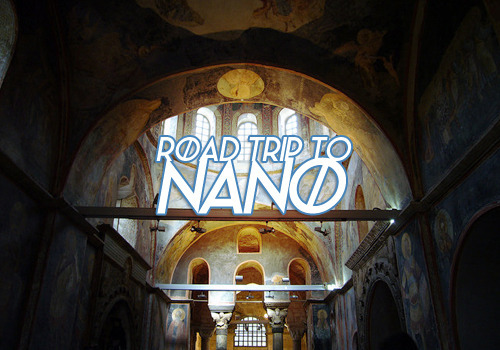
NaNoWriMo is an international event, and we’re taking a Road Trip to NaNo to hear about the stories being written every year in our hundreds of participating regions. Today, Ayfer Simms, our Municipal Liaison in the Elsewhere :: Turkey region, talks about the importance of writing being a beacon of hope and resistance in dark times:
Turkey. On the news recently quiet a bit, hey? A punch in your stomach. Yes, the old has always been here––those exquisite ruins paving the streets, the noise, the animals, under, above you, a punch in the face: ears, eyes, mouths, everything wide open. The country is now besieged, free expression locked up in small dark taverns, but the light shines, and the new resistance, believe it or not, is art.
We writers have a lot to say here. We do not “do” politics; we are citizens, we breathe it. Our characters are heroes: imprisoned mortals who are full of rage; who, despite the chains digging into their skin, shake the system within themselves and don’t give up. In our region, to survive, we must let our hair down, chip those chains away, and write with our hearts, wide open like a fresh incision. Here in good old Turkey, there are a thousand elements to talk about.
I have never “prepared” a single NaNoWriMo novel, but I have always had a phrase appear to me, a feeling emerge, close to the time. September is the best time to decide on a subject. What I have learned is that in November, the ground will become quicksand, your structure will crumble, your plan will tremble and may crush you. Stick to freedom, destroy fear, let the light in, let your limbs go loose: NaNoWriMo is not about making something that perfectly fits a mold, it’s about unlocking your creative mind.
Your story is not always what you think it is. Your story can sometimes turn out to be the opposite of what you imagined you were writing. While you focus on your subject, try to open yourself to everything that’s around it. Whatever you are about to write in your first draft will be the skin of your story, but in the process of writing it, you’ll discover that you want to go underneath the surface, where it hurts, down to the jolting of the blood in the story’s veins and the layers of feelings you weren’t at first aware of.
“Whatever you are about to write in your first draft will be the skin of your story, but in the process of writing it, you’ll discover that you want to go underneath the surface…”One of the main things I’ve found really helps this discovery process is to avoid clichés and shortcuts. How would you tell the story of a country, city, or world ruled by an evil antagonist, for example? Would you create a larger-than-life hateful figure who points a metal fist to an angry crowd, arrests, locks up, knocks out, and tear-gasses everyone he meets? …nah.
It depends on how you operate: on your memory, visual or auditory; on your personality, prone to dreams and receptive to unconscious thoughts or utterly logical. Once you dive down to the part of the story you can’t see with your bare eyes, the light of the story you want to tell will shine through. And there it is: lightyears away from what you thought you were working toward, but you have it, the real message you hoped to convey.
Maybe the dictator has disappeared from your story. Perhaps instead you have a postman, a librarian, a cook, a disenchanted rocker, a martial artist. You have it. Your hero is beautiful because they resonate not only in the universe you’ve created, but in the one you live in as well. Clichés can resonate too, yes, because they are a part of the bigger story of the people around you. But when you avoid clichés, your story will stand out instead of being buried in the mass of similar material that other people have written. You’ll still be part of that big, anonymous entity of writers telling stories of oppression and resilience, but your unique hero will rise up: immortal, barefoot, wild and strong. A punch, one that stops in thin air; a blow, a tempest, the end of the world. It will be you.
NaNoWriMo in Elsewhere :: Turkey

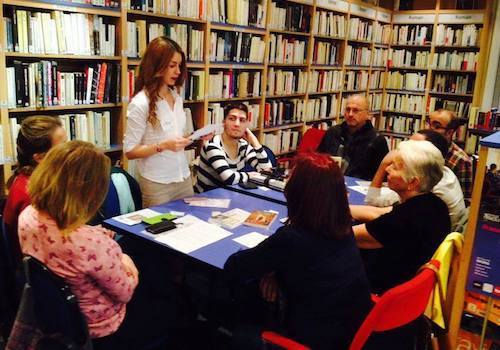
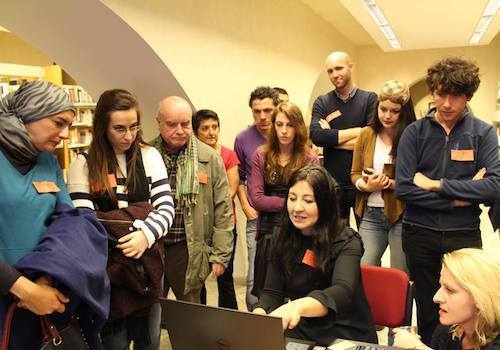

Ayfer Simms has lived in Istanbul, Turkey, since 2013. Her parents immigrated to France before she was born and therefore she grew up near Paris. After university she started to have itchy feet and has been traveling ever since. She’s wanted to be a writer since she was 12, but NaNoWriMo taught her to go all the way. She is married and has a daughter, and loves David Lynch and practicing Aikido. She works at the cultural French institute at the library, which is a pretty great job for a literature-lover.
Top image licensed under Creative Commons from Jofre Ferrer on Flickr.
September 15, 2017
Meet Our New NaNo Interns, Kristen and Nick!

We feel super lucky here at NaNo HQ to be able to work with some excellent interns! Today, meet Operations Intern Kristen Sibbald and Editorial Intern Nick Fierro, the newest additions to our team. You’ll be getting to know them better as a co-hosts of Virtual Write-Ins throughout November, but today these two Bay Area natives are sharing the importance of “keeping the familiar strange”, as well as some hearty cheering for everyone participating in NaNo this year:
Hey writers! I’ve just returned to my native Bay Area to start this internship, after four years in Southern California studying at the perpetually sunny Scripps College. It’s a strange adjustment to be back, but I’m also excited to work with the amazing folks at NaNoWriMo and to have fog in my life again.
I’ve always been plagued by wanderlust and the desire to search for stories, and it’s taken me to some interesting places. For instance, in my studies of Latin America I’ve travelled around Nicaragua, studied youth culture in Cuba, and investigated border development in Costa Rica.
But since I’ve been back in the Bay, where I grew up, I now see it in a different light, with the perspectives I’ve picked up from my travels and studies and relationships. And I’ve realized that it’s important to keep the familiar strange, to notice the life and culture in the places where I already am. These insights are, to me, more valuable than the perspectives of an American commenting on the seemingly strange customs of another nation. I find that my observations often tell me more about my own perspective and sense of normality than about the things and people I’m observing. As I re-explore my favorite places from childhood and continue to learn in this internship, I’m excited to challenge myself to interrogate my existing ideas. Maybe I’ll incorporate the experience into my NaNoWriMo novel in November.
When I’m not scribbling in a notebook or daydreaming in a coffee shop, I like to draw badly, grow flowers, defend the Oxford comma, and bake cakes.
From Nick:Hey folks! My name is Nick Fierro, and I’m so pleased to be your Programs Intern for the fall!
I’m a Northern California native, and a recent returnee after a 4-year stint at Washington University in St. Louis, where I studied Philosophy-Neuroscience-Psychology (one major). Although both the Bay Area and NaNoWriMo are familiar territory to me, this marks my first time celebrating NaNo from “behind the scenes” at the Office of Letters & Light.
A few facts about myself:
I lived in Scotland for six months during my junior year of college. I arrived a bright-eyed Californian with dreams of Nessie, kilts, and castles, and left with a deathly pallor and an appetite for haggis. I’d do it again in a heartbeat.
In recent years, I’ve been focusing on writing more nonfiction, including journalism, culinary writing, and satire (often combining the three). However, fantasy was and remains my first and greatest love.
Like so many of you, my first experience with NaNoWriMo could be described like an elaborate smoothie: one part intellectual curiosity, one part self-betterment, one part sheer terror, seven parts coffee, and a shot of adrenaline––sprinkled, of course, with a deep love of all things writing. Although that smoothie didn’t win any taste-tests, NaNoWriMo was one of the first creative outlets I had where I felt like my efforts were really building towards something––even if that “something” was still a work in progress.
I’m looking forward to lending a helping hand to the NaNo team and standing alongside them as November fast approaches. I’m still unsure what this year’s novel will be, but rest assured I’ll be pantsing––or perhaps plantsing––alongside each and every one of you. Most of all, I’m excited to join in cheering on the hundreds of thousands of writers who will participate in NaNo this year, so for those about to write, I salute you.

Chris Baty's Blog
- Chris Baty's profile
- 63 followers



